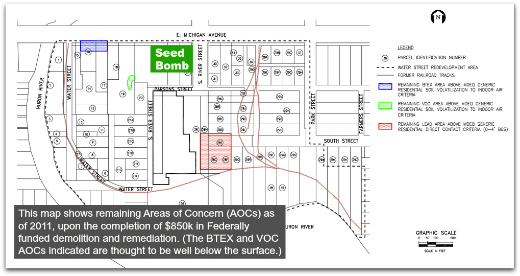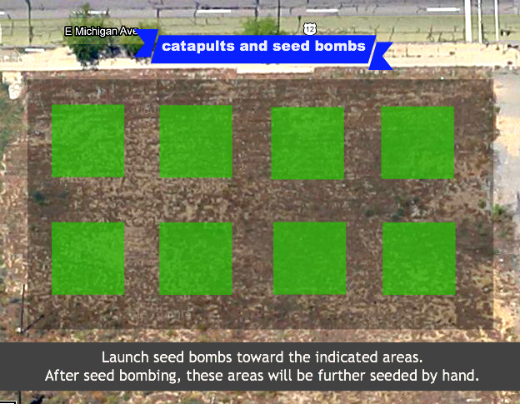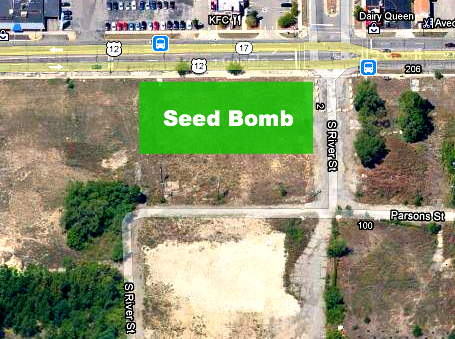On Thursday evening, the Ypsilanti Parks and Recreation Commission met, and considered our proposal to adopt an acre of Water Street right alongside Michigan Avenue, just west of South River Street. I don’t think it will be official until Monday, but the members present agreed unanimously with the project as I explained it. So, it looks like we, the people of Ypsilanti, now own an acre of the former brownfield at the heart of our city, at least until such time that a developer comes forward to purchase the site. Here, if you haven’t seen it yet, is a map showing the area in question… which, as you can see, is relatively far away from the remaining areas of contamination.
Image may be NSFW.
Clik here to view.
So, while there are still a few issues to be worked out, it looks as though the seed bombing of Water Street will happen on Wednesday, May 1… While we’ll likely have a school group or two come out during the day to throw a few seed bombs, my sense is that the bombs will begin raining down in earnest at about 5:00 PM. Things could, of course, change, but, as of right now, the plan is to have people standing on the sidewalk, and launching their seed bombs, either by hand, trebuchet or slingshot, into the field, aiming for one of eight areas where we’d like to concentrate our efforts. (I hope to have those areas marked with flags that people can aim for.) We realize, of course, that some seed bombs will fall outside these areas (marketed in green below), but we’re thinking that it makes the most sense to focus on these distinct plots, for reasons I’ll get to after this aerial view of the site.
Image may be NSFW.
Clik here to view.
The idea of focusing on smaller target areas comes from my friend Jason Tallant, who, for the past ten years, has been handling ecological restoration projects for the city of Ann Arbor. In Jason’s experience, what you want to do in instances like this is increase the number of “edges” between the newly planted native species and the invasives you’re looking to displace. Those dividing lines, says Jason, are where the intense competition between species will happen. And that’s what we want. We want to create eight strong native cores that plants can then radiate out from, battling with the spotted knapweed, and the like. (The goal eventually is to have the entire acre filled with native species.) Toward that end, we’ll be lining up volunteers prior to May 1, to turn over the ground in these eight areas, and get the soil ready for our seed bombs. (We’ll also be removing invasives at that time.) Then, after the seed bombing, some of us will go through and seed those areas by hand, making sure that we’ve got seeds planted right up to each of the 32 edges that we’ve created.
Here’s a satellite image of the space in question, which will show you where we’ll be working in relation to the Dairy Queen.
Image may be NSFW.
Clik here to view.
As I expressed the last time we discussed the possibility of seed bombing Water Street, a great many people have come forward with ideas as to which native plant species we should include. I’d reached out to the folks at Ann Arbor’s Native Plant Nursery, Mason’s Wildtype, Ann Arbor’s Wild Ones chapter, the Michigan Botanical Club, the Michigan Native Plant Producers Association and the MSU Extension Service, and almost all of them got back to me with suggestions. And I’ve spent the past several days synthesizing the information, and trying to determine the most cost-effective and impactful way forward… As Bill Schneider from Wildtype astutely pointed out to me, the key is to “balance the aesthetic and the horticultural”. We want immediate pay-off in terms of attractive native plant growth, in order to show progress, and secure the support of folks in the City, but, at the same time, we also want to move things forward in a way that’s ecologically sound.
So, I’ve spent the past week knee-deep in emails with people debating the relative merits of Jerusalem artichokes and butterfly milkweed, and trying to determine which species of natives might actually stand a fighting chance against the hardy invasives that have already taken root. And here’s what, as of right now, seems to make the most sense.
4-6 species of forbs:
Yarrow, Black Eyed Susan, Common Evening Primrose, Common Milkweed, and/or Sand Tickseed1-2 grasses:
Canada Wild Rye and Indian Grass
According to Jason and Bill, this mix would be good because suppliers are likely to have the quantities of seed that we need, they aren’t generally expensive, and, most importantly, they’re competitive. “These species,” according to Jason, also “produce reliable seed, are pollinated by wind, generalist insects and birds, and are successful in establishing themselves in intense conditions.”
It may not, perhaps, be the sexiest wildflower mix, but it should be a great first step toward turning this parcel around, and breathing some life into the former industrial site… And, there’s nothing stopping us from transplanting some butterfly milkweed, and a few shrubs, along the Michigan Avenue edge.
Now, unless there are any objections, I need to reach our to seed suppliers and see if they have seeds for the forbs indicated above that are already cold-stratfied. (If they aren’t already cold-stratified, they’ll won’t germinate and produce plants until they’ve been on the ground through a winter.)
There are still, of course, things that need to be worked out… not the least of which is how we’ll raise the funds for seeds and clay… but I think we’re well on our way. We’ve got the City behind us, over 160 people have joined our Facebook group, and my sense is that the pieces are starting to fall into place. The next step is to get seeds, compost and clay, and start making bombs.
To stay up-to-date on the project, please join the Seed Bomb Water Street group on Facebook… and be sure to put May 1 on your calendar. It should be fun.